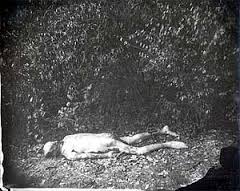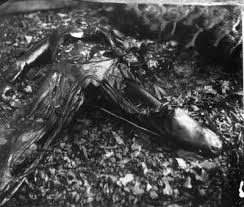Ancient Egypt is widely recognized for their advanced process of “mummification” which successfully prevented natural decomposition. These purposefully preserved “anthropogenic mummies” have been found in various ancient civilizations throughout the world and were created by exposure to chemicals, extreme cold, extremely low humidity and/or lack of air. Spontaneous Mummification/natural embalming can occur under the same conditions. The oldest known natural mummification was observed in a 6,000 year old severed head discovered in South America in 1934 which was found to be of the Incan Civilization. Most people are familiar with the image of a “normal”, dried up mummy, a body which did not go through the process of Putrefaction due to dehydration of the corpse; However, there are many variations on spontaneous mummification/natural embalming which you may not be familiar with.
1. Consistently Cold Corpses
Mt. Everest, located in the countries of Nepal and Tibet is the highest mountain in the world and a frozen graveyard for over 200 bodies of climbers who perished during their expedition. Due to the severe temperatures and extremely high altitude, bodies of those who die on Mt. Everest are usually unable to ever be recovered. The persistent subzero temperatures prevent these bodies from fully decomposing and are used today as markers for climbers on their way to the peak. Take for example the body of George Herbert Leigh Mallory.

Body of George Herbert Leigh Mallory on Mt. Everest. Courtesy of Atlas Obscura.
Mallory and his companion died during a British expedition to the peak of Mt. Everest in 1924. Unfortunately, no one knew what happened to the two explorers until a team searching for their remains discovered Mallory’s corpse on May 1,1999. Despite having died more than 70 years prior, his remains were found in almost pristine condition, preserved by persistent subzero temperatures. If you make the death-defying trek to the peak of Mt. Everest, make sure to stop by and visit George Herbert Leigh Mallory.
2. Bog Bodies
Peat bogs, also known as “alkaline mires”, are wetlands abundant in mosses and wonderful environments in which to naturally preserve a corpse. In fact, the “Tollund Man”, considered to be the most well-preserved pre-historic corpse to have ever been discovered was found in a peat bog on the Jutland Peninsula in Denmark.

The Tollund Man
The Tollund Man, discovered in 1950, most likely lived between 375 BC and 210 BC during the Pre-Roman Iron Age. Although his body has shrunk and his arms and hands (aside from one finger) have skeletonized, his facial features were preserved perfectly. The right side of the Tollund Man’s body, which was fully submerged in his alkaline grave, shows less skeletonization and shrinking than the left. He was discovered wearing a pointed cap of sheepskin secured to his head with two leather straps tied beneath his chin, a leather belt and a leather noose around his neck. It was determined the noose had been cut from the remainder of the rope with a knife. Indentations found on the front of the Tollund Man’s neck indicate he died by hanging. It is unclear why he died by hanging (execution, suicide, etc.) and whether or not his body was intended to be preserved by the bog. Today, the Tollund Man is on display at the Silkeborg Museum in Denmark.
3. Soap People
Adipocere, also known as Saponify is an incredibly uncommon and fascinating form of postmortem preservation which occurs in an alkaline and/or warm, airless environment containing moisture. Saponification is a modification on Putrefaction in which the body’s fat converts into an acidic, insoluble soap which inhibits the growth of bacteria necessary for the body to putrefy. Generally, at the time of death a body contains 0.5% fatty acid, but in adipocere, levels of fatty acid rise to 20%. Within three months, bodies that saponify will contain 70% fatty acid. At first, saponified bodies will smell strongly ammoniacal. Curiously, people who have examined saponified bodies note that this smell will eventually wear off, but will return once more if the body is exposed to fresh air for two minutes or longer. Fresh adipocere appears soft, moist, white and translucent. Eventually, the body will become very brittle appearing to be hard, dry, cracked and will take on a yellowish color. Some internal organs may saponify as well, others will become similar to parchiment paper. Although the body may eventually decay if environmental conditions alter, usually the corpse will remain in a state of adipocere for at least a few decades after being relocated. A human body takes approximately 3-6 months to saponify completely, but it can begin to form in three weeks, given the right conditions. While it is unconfirmed, reports from India claim saponify has begun to form in as little as 3-4 days. The most well-known example of adipocere is the “Soap Lady”, whose saponified body was exhumed in Philadelphia in 1875.

The Soap Lady. Photo courtesy the Mutter Museum.
Originally believed to have been an elderly victim of the 1790’s Yellow Fever Epidemic (due to her lack of teeth), it was discovered in a 1987 X-ray that her clothing contained buttons and pins which were not manufactured in the United States until the 1830s. It was also determined this toothless woman was much younger, having died no later than her 40s, possibly as young as her late 20s. The Soap Lady is currently on display in Philadelphia’s Mutter Museum.
4. Volcanic Ash
In 79 AD (most likely August 24th, around noon) Mt. Vesuvius erupted destroying the cities of Herculaneum and Pompeii. While Herculaneum was immediately incinerated by the initial pyroclastic surge, at least 1,150 citizens of Pompeii were encased in a porous pumice shell leaving behind a macabre cast of their position at the time of death.

Bodies in Pompeii
Many people are under the impression that the bodies of those killed in the destruction of Pompeii remain encased in the pumice however, this is false. While their skeletal remains are inside, the soft tissue decomposed and eventually leaked out of the hardened ash. In 1864 Giuseppe Fiorelli was serving as executive director of excavations at Pompeii. He instructed his team to not remove bones of the volcano’s victims and to instead pour plaster into the pockets of ash left behind where the soft tissue had once been. After a few days the plaster hardened, leaving us with 150 “statues” of Vesuvius’s victims immortalized in the final, terrifying moments of their life.
5. Incorruptible Corpses
Until rather recently, the Catholic Church considered “Incorruptible Corpses”, bodies that do not decompose after death, to be a miracle. Once upon a time, holy figures which remained immaculate long after their demise quickly gained Sainthood. While lack of decomposition is no longer officially considered a “miracle” in itself, there is still the belief within Christianity that these faithful few whose earthly bodies are spared decomposition are still in some way touched by God. There have been many claims that these bodies smell sweet and floral and at times appear better postmortem than they did in life… Those of us who are not quite as full of… “The Holy Spirit” realize there are legitimate scientific reasons behind these bodies that for whatever reason, do not putrify. In modern times, it has been discovered that some of the tombs used as a resting place for devoted Catholic nuns and priests are more conducive to natural embalming than others. Temperature, moisture and even architecture all influence the tomb’s ability to naturally preserve a corpse. One of the most famous Incorruptible Corpses is that of Saint Paula Frassinetti who was buried in one such a tomb in 1882.

Body of Saint Paula Frassinetti. Photo courtesy of The Order of The Good Death
In 1906 her body was exhumed to be moved to another location. At that time it was discovered that St. Paula’s body had only slightly decomposed in 24 years time. In light of this, her corpse was displayed at Saint Onofria, the Dorothean motherhouse in Rome, Italy. Unfortunately, after her body was removed from its original tomb, St. Paula did begin to decompose. In an attempt to keep her body in its state of incorruptibility, Sisters at the convent washed St. Paula Frassinetti with acid which slightly melted her skin. It did, however, prevent any further decomposition. Incorruptible Corpses often receive such treatments in an effort to maintain the body. Her corpse remains on display to this day and those who have handled the body of Saint Paula Frassinetti claim she is still quite flexible.
Learn more about The Mutter Museum
Learn more about The Silkeborg Museum
Check out the NEW BOOK by The Post-Mortem Post’s Head Writer ‘Horrible History: Mass Suicides’ AVAILABLE NOW on Amazon Kindle!
Follow us on Twitter @PostMortem_post
From the same demented mind that brought you The Post-Mortem Post: FREAK
If you enjoyed this article, you may also like Burying the Dead is Killing the Planet, Everybody Poops: The Post-Mortem Edition and How to Decay the Good Ol’ Fashioned Way



































